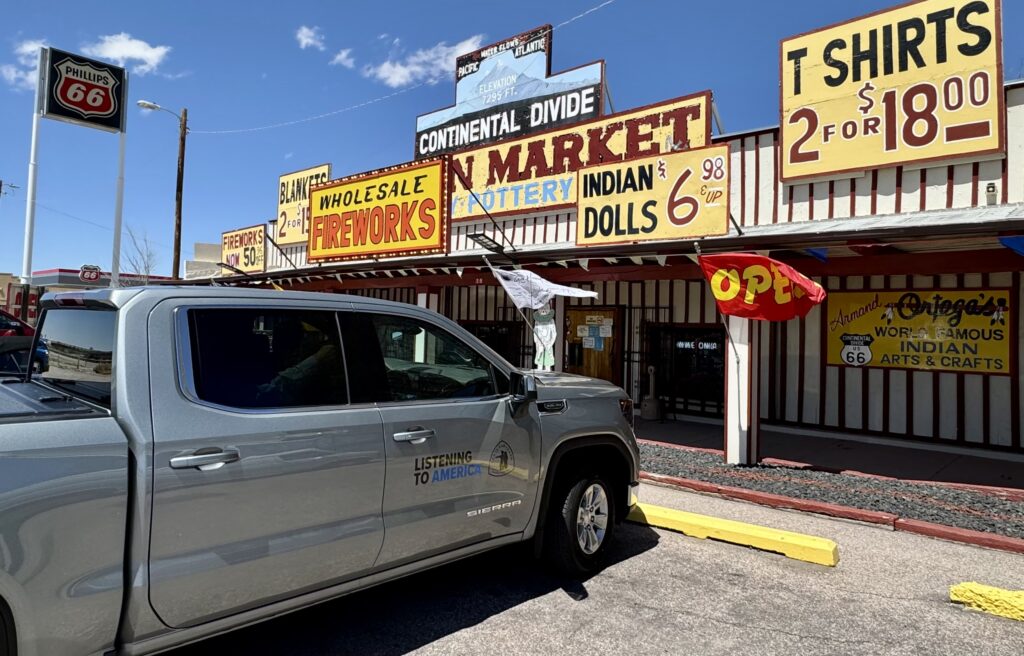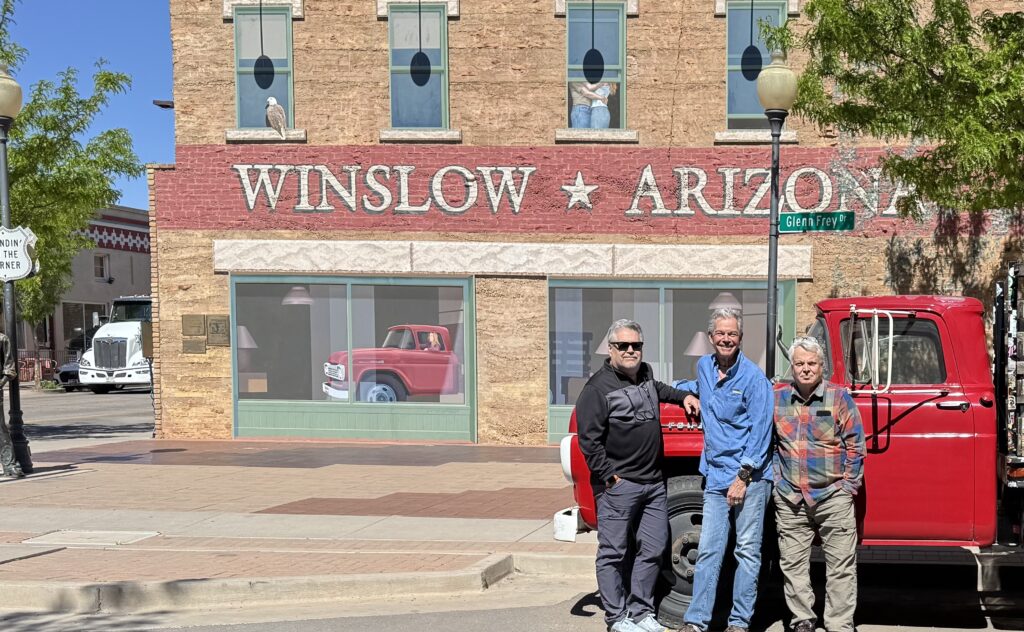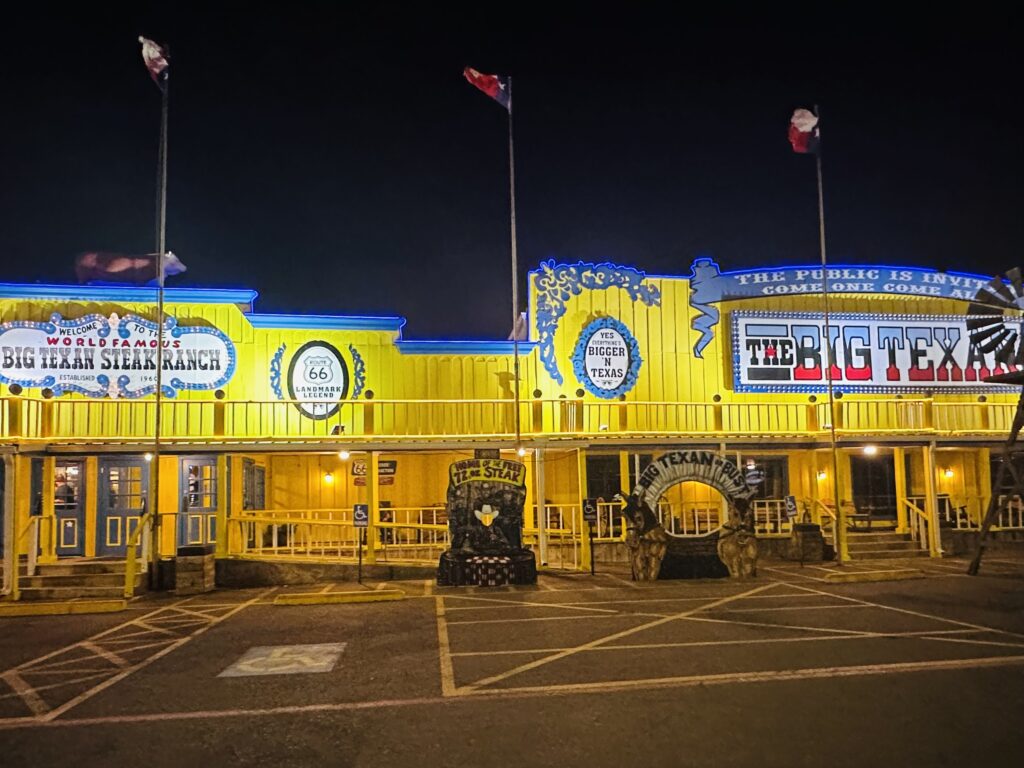About three days and 2,870 miles: Clay makes a rapid dash across the continent.

Now, in Salisbury, North Carolina, the home of my friends and colleagues Russ and Liz Eagle. It’s a long story, but over the past three days, I drove with Russ from Bakersfield, California, to North Carolina, a distance of 2,870 miles. I would have liked to dawdle and double the transit time, but I had miles to go before I slept — as Robert Frost put it — and promises to keep.
I sadly conformed to John Steinbeck’s 1960 Travels with Charley prediction: “When we get these thruways across the whole country, as we will and must, it will be possible to drive from New York to California without seeing a single thing.”
Well, not quite.

What do I remember? The drive up Tehachapi Pass from west to east is dramatic and formidable. I’ve driven it in both directions four times last year and still marvel at its formidability. The Union Pacific Railroad track actually performs a 3,779-foot spiral loop to “make the grade” (the original meaning of that phrase). If the train has more than 56 cars, it actually passes over itself as it climbs to the summit, which is just 3,771 feet high, but “travels” much higher. Last year, my 2013 pickup labored pathetically up the highway (California 58) and nearly boiled over like a jalopy out of Steinbeck’s The Grapes of Wrath. That incident led to a new 2025 GMC pickup, the gift of Listening to America well-wishers in Bakersfield. Steinbeck’s Joads stopped on the west side of Tehachapi Pass to look down for the first time on the promised land, the lush and fertile Central Valley of California. (Little did they know what awaited them.) We did not stop to gaze down from the The Grapes of Wrath vantage point for two reasons: The valley was hazy, and we were hurrying to cross the continent.
Crossing the Mojave Desert was a piece of cake in a 21st-century vehicle with air conditioning. I am old enough to remember when people braced for the transit, filling every available vessel with water and checking the oil before the nerve-wracking sprint. In Travels with Charley, Steinbeck wrote: “The Mojave is a big desert and a frightening one. It’s as though nature tested a man for endurance and constancy to prove whether he was good enough to get to California.” This is no longer the case, except for people driving very old cars. We waltzed through the parched countryside, observing the scattered Joshua trees, the improbable and dusty desert towns, and the lone single-wide trailers far off in the distance, inhabited by people who wanted, for one reason or another, just to be left alone. In several places, we saw acres of parked Boeing commercial airplanes — graveyards of retired planes, or maybe just outdoor storage until needed again.
We drove through the endless Chocolate Mountains of southeastern California and stopped to marvel at the Colorado River as it begins its final stretch to Baja.
We stopped at Winslow, Arizona, long enough to have our picture taken “standing on the corner” of Kinsley and East Second Street and to buy a map of Route 66, which we paralleled but never succumbed to in our rush.

As we churned through New Mexico, we saw endless scrub country stretching out in every direction. We passed the amazing Acoma Pueblo site and Chaco Canyon (one of the most sacred places in the Southwest) without stopping. I identified Mount Taylor (one of the four sacred mountains of the Navajo and sacred too to the Acoma Pueblo). I grumbled about the appallingly inappropriate ways landforms in the American West have been named for the conquerors. Zachary Taylor (1784-1850) was a slaveholder and an “Indian fighter,” and so he got himself a mountain in the very heart of the Indigenous Southwest.
It’s Bigger in Texas
When you cross the border into Texas, you are immediately made to understand that you are in a unique state (both in geography and spirit). Steinbeck wrote, “Writers facing the problem of Texas find themselves floundering in generalities, and I am no exception. Texas is a state of mind. Texas is an obsession. Above all, Texas is a nation in every sense of the word.” Every billboard announced the biggest and grandest this or that, and about half of them invite you to try to ingest the 72-ounce beefsteak at the Big Texan Steak Ranch. We passed the garishly yellow Big Texan, but we did stop in Amarillo to have Texas barbecue with our friend Joe.

Texas is, as Texans remind us endlessly, huge. Larry McMurtry has an essay about driving across Texas, and he — as a full-blooded Texan — expressed a slightly nauseous amazement at the state’s sheer size. What impressed me most about our one-day transit was how much Texas changes from the parched shortgrass West to the lush semi-Louisiana-esque East. And that doesn’t account for Lyndon Johnson’s Hill Country, the sauna of the Houston-Galveston coastal corridor, or Texas’ most international city, El Paso.
Every 20 miles or so as we hurtled along the northern tier of Texas, the land was a little better vegetated, greener, and with vastly more trees than the semi-arid Panhandle. I knew that Texas had an enormous number of counties — 254 — but I was surprised at how many scores of struggling small towns there are, each with a once-vibrant brick downtown, now half boarded up and such commerce as there is out on the edge of town. If I had had a copy of McMurtry’s essays, I would have read some of them out loud to my traveling partner Russ. If anyone knew Texas, it was McMurtry, whose The Last Picture Show is as great as Lonesome Dove.
Another thing you learn by driving across America is how much dispiriting homogeneity there is in cities of more than 10,000 people. The same motels (Holiday Inn Express, Best Western, Super 8, Motel 6, maybe a Hilton Garden Inn), the same fast food (starting with Dairy Queen, Subway, and Sonic and moving on to McDonald’s, Arby’s, Burger King, Pizza Hut), and the same chain stores (Walmart, CVS Pharmacy, NAPA Auto Parts, Dollar General). It’s Anywhere USA and also Nowhere USA, drearily repetitive and bland and yet at the same time a little reassuring. If you were dropped blind into any of these places (the suburbs of St. Cloud, Minnesota, Salem, Oregon, or Crystal Lake, Illinois), you’d be unable to discern where you were in America. The swallowing up of local commerce (the old clunky office supply store yielding to Office Depot and the ma-and-pa men’s and women’s clothing stores losing their customers to Target or maybe one of the last J.C. Penney stores) is as predictable as it dispirits.
Amazon’s Ubiquity
Perhaps even more startling is the sheer number of Amazon vans, semis, and railroad container cars all across America’s highways. I don’t exaggerate when I report that we saw hundreds, maybe even low thousands, of Amazon vehicles and containers. It’s astonishing. As a serial and obsessive Amazon shopper (almost exclusively of books), I plead guilty. I’m guessing that Amazon is now America’s principal monopoly. One of my liberal friends instructed me “never to buy anything from Amazon again,” and all I could do was guffaw. Boycotting Amazon is like trying to knock down the Great Wall of China with a BB gun.
Amazon now sells well over 40% of all books in the United States, but the vast variety of other things (from clothes to groceries and jewelry) play havoc with local commerce. Amazon represents 37.8% of all American e-commerce. One in three Americans has an Amazon Prime account. By now, Amazon is as much a national goods distribution system as anything else, delivering the products of more than 2 million small and medium-sized businesses worldwide. Walmart stores are ubiquitous in America (4,605), but Amazon dwarfs Walmart’s sales. What would Theodore Roosevelt, the great trust buster, do about Amazon? He read a book a day, so you do the math.

If Steinbeck were making this 2025 transcontinental journey, he’d probably devote a long passage to the sudden proliferation of premium car washes in America. I remember when the first car wash came to my hometown in western North Dakota in about 1970. The local television station produced a 30-minute special about that car wash, including an interview with the owner and a step-by-step tutorial on operating it. We were assured that the high-pressure hoses would not scour the paint off our vehicles. And we were informed that though it required quarters to operate, there were plans to install a change machine soon. An age of innocence! Today’s spectacular new car washes feature architectural flourishes, bold paint jobs, arches and flourishes, a long array of vacuum cleaners that will suck baseballs or hammers out from under the back seat, and conveyors that carry half a dozen vehicles through the process like a Detroit assembly line.
By the time we reached the Louisiana border, we were beginning to flag. Finally, we reached Shreveport, Louisiana, where we had kin and friends, and we paused for about 18 hours. There was gumbo and an offer of grits. After that, it was an even less observant romp through Mississippi, Alabama, Georgia, South Carolina, and finally to Salisbury, North Carolina, including rush hour delays in Atlanta and Greenville-Spartanburg. We were so weary now that we drove like Steinbeck after New Orleans — on pitiless adrenaline and a physical and psychic numbness that blurred everything but the asphalt and concrete immediately ahead of us. The last day of the journey began at 4:45 a.m. and ended at 8:15 p.m. (852 miles) and we only stopped for fuel and the rest areas forced upon us by our colossal intake of caffeine-laced drinks.
Yesterday, after a good enough night of sleep, we fetched the Airstream out of storage. There was some drama as there was almost no room to extricate it in the narrow avenue between storage bays with my new, longer pickup, and I made the usual rookie mistakes with backing up. After we recovered our dignity, we took it to a giant truck stop to get the propane tanks topped up and to flush the pink antifreeze goop we’d poured into the tanks last November.
And that’s when we discovered a serious leak in the plumbing. We are still unsure why, but as soon as we filled the tank with 30 gallons, all that water leaked out from under the rig. So now, as I write these words, I am waiting for word from the ma-and-pa RV repair shop to call to announce one of three things: 1) there was only a broken water hose and all is well; 2) this will need a range of new parts that will have to be ordered and probably I cannot get the rig until mid-next week; 3) at this point we may as well pour kerosene over the Airstream and light a match, and see the country by way of Greyhound buses. (I’m guessing it is number two.)
So it is no wonder, as Simon and Garfunkel put it, “I’m empty and aching, and I don’t know why.” “We’ve all come to look for America,” and I ain’t seen nuthin’ quite yet.
Stay tuned. Year Two begins.
